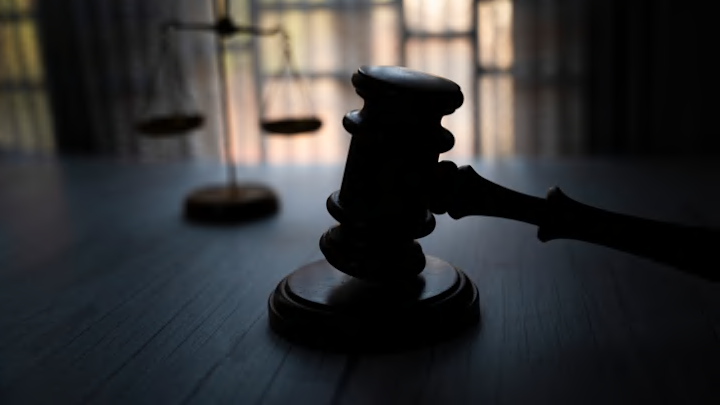Though it’s not often that the paranormal and legal intersect, the line between hauntings and hearings has occasionally been blurred. After all, every trial needs a good witness, even if they’re (un)dead. These five cases used “spectral evidence” to render verdicts.
- The Greenbrier Ghost
- John Tregeagle’s Deal With the Devil
- The Salem Witch Trials (and Similar Proceedings)
- The Ouija Board Bungle
- Teresita Basa Solves Her Own Murder
The Greenbrier Ghost

In October 1896, 23-year-old newlywed Zona Heaster Shue was found dead in her home in Greenbrier County, West Virginia. The coroner listed Zona’s cause of death as heart disease.
Shortly thereafter, Zona’s mother, Mary Jane Heaster, claimed she was visited by her daughter’s spirit on four consecutive nights. The ghost told her that Edward Shue, Zona’s husband, had been her true killer, and Mrs. Heaster convinced the local prosecutor to reopen the case. Zona’s body was ordered to be exhumed for reexamination. Then the coroner who had conducted the original autopsy admitted Edward had interfered with a thorough examination of the body.
The second time around, her body was found to have a crushed windpipe and broken neck, pointing to her actual cause of death as strangulation, not heart disease. Edward was arrested for his late wife’s murder, and Zona’s mother testified to her spectral visions, leading to a guilty verdict in the case and Edward’s life sentence. The ghost’s tale was not the sole piece of evidence pointing to Edward’s guilt, but it’s one of the only known legal cases in which a spirit’s testimony helped secure the conviction of a murderer.
John Tregeagle’s Deal With the Devil

John Tregeagle, a Cornish attorney in 17th-century England, was rumored to have made an unholy deal with the devil in exchange for abundant wealth. He was a harsh magistrate, accused of everything from cheating an orphan out of an inheritance to the murder of his own wife. He allegedly sought absolution for his wicked ways, but he died and was buried in Wadebridge, Cornwall, before he was able to escape his Faustian bargain.
Tregeagle—or rather, his ghost—reappeared a short time later when his name was invoked during an ongoing court case. According to the legend, the defendant called the now-dead Tregeagle as a witness in a last-ditch effort to win the case, and the ghost of the magistrate materialized on the stand to be questioned by the judge. After the ghost’s testimony concluded, it fell to the local clergy to dispatch his spirit back to the afterlife. Legend says they devised a series of impossible tasks for Tregeagle’s ghost to toil over while he awaited Judgment Day.
You May Also Like:
- Assault, Robbery, and Murder: The Dark History of “Bedsheet Ghosts”
- The Hidden, Haunted Histories of 7 American Landmarks
- Why Do Ghosts Say “Boo”?
Add Mental Floss as a preferred news source!
The Salem Witch Trials (and Similar Proceedings)

In 1692, a group of young girls in Salem, Massachusetts, complained of being tormented by spectral entities, sparking one of history’s most notorious and well-documented witch hunts. The girls gave statements alleging they’d been tortured and possessed by agents of the devil controlled by witches hiding among their fellow villagers, and their testimonies were admitted to court as “spectral evidence” (testimony resulting from paranormal visions, messages, or dreams). The multiple trials of women and men accused of witchcraft resulted in the executions of 19 people.
While Salem might be the most infamous instance, persecution of people as witches occurred regularly throughout Europe in the 16th and 17th centuries. Many of these trials relied—sometimes solely—on spectral evidence to convict the accused.
The Ouija Board Bungle

In late 1994, 35-year-old insurance broker Stephen Young was convicted of the murders of Harry and Nicola Fuller following a grueling double homicide trial. Young had been motivated by mounting personal debts and had broken into the newlyweds’ cottage to rob them before he shot and killed the pair.
Young’s conviction and two life sentences were overturned by the UK Court of Appeals when it came to light that a group of jurors had consulted a Ouija board while staying overnight at Brighton’s Old Ship Hotel. After fashioning an ad hoc Ouija board using a piece of paper and a wine glass, four jurors had attempted to call upon the spirit of Harry Fuller to guide them in their impending deliberations. The ghost of Harry, having successfully identified himself, allegedly told them he had been shot by Young and encouraged them to convict him the following day.
When the juror’s unsanctioned spiritual consultation became public, the Fullers’ family members had to endure Young’s weeks-long retrial. He was again found guilty of the murders and given the same life sentences.
Teresita Basa Solves Her Own Murder

On the evening of February 21, 1979, residents of a Chicago apartment building reported a fire in one of the units. Police investigating the incidence then found respiratory therapist Teresitsa Basa dead with a stab wound to her chest, underneath a partially burnt mattress. Without any viable leads, the case quickly ran cold.
Then Remy Chua, a colleague of Basa’s at the hospital where she had worked, called the officers and claimed that she’d been contacted by the deceased woman’s spirit through a series of dreams shortly after the murder. Chua had dictated the visions to her husband. Basa’s spirit allegedly told her that she’d been murdered by another colleague, an orderly named Allan Showery.
Though deeply skeptical of Chua’s source, detectives on the case followed up on the claims and discovered Showery was in possession of jewelry stolen from Basa’s home. Authorities questioned Showery and ultimately secured his confession to the crime as well as a 14-year prison sentence. While Chua’s sworn testimony was not the sole piece of evidence used in convicting Showery, it played a key role in guiding authorities toward the perpetrator.
